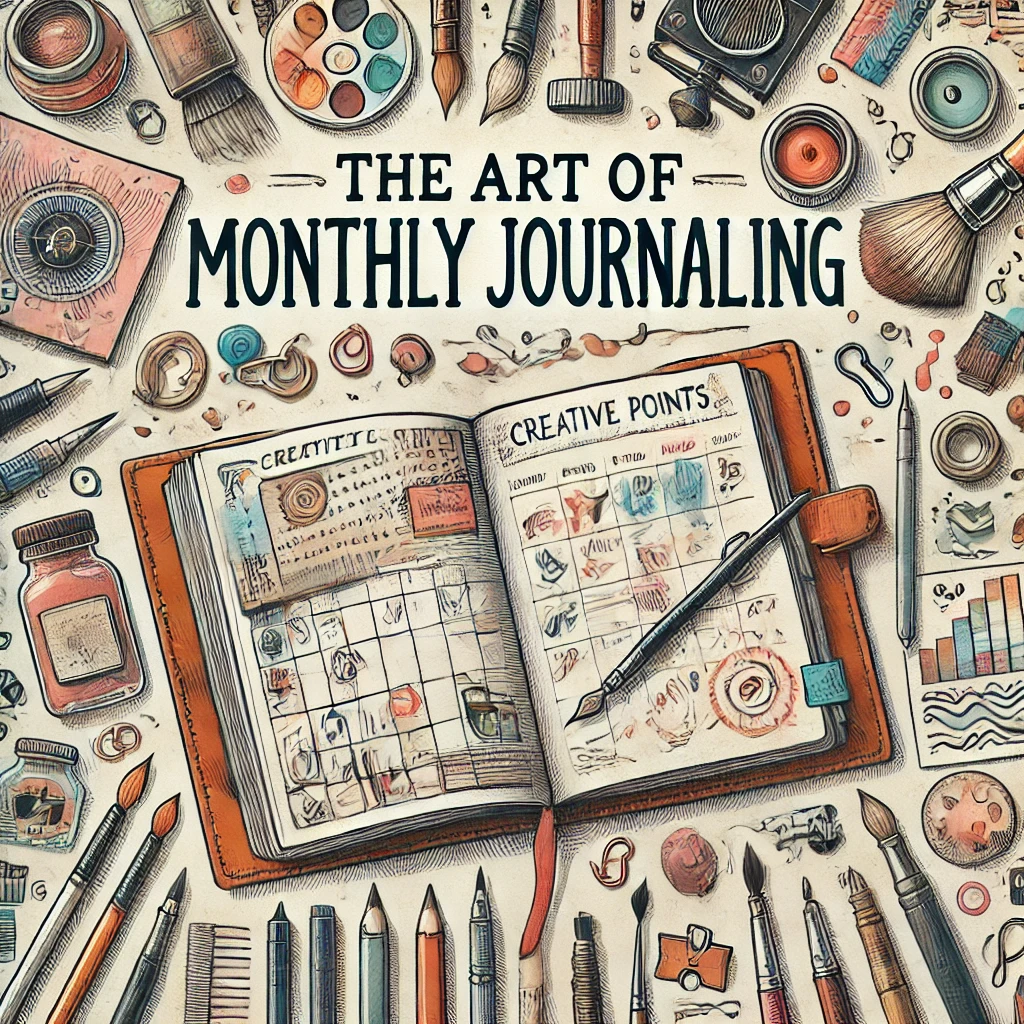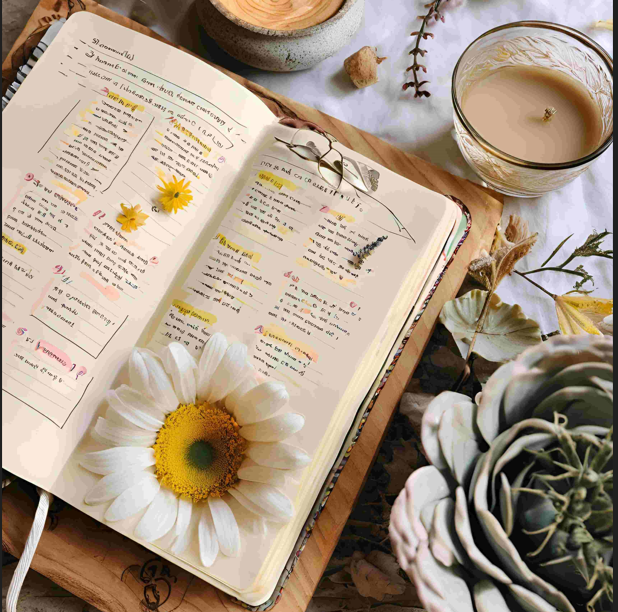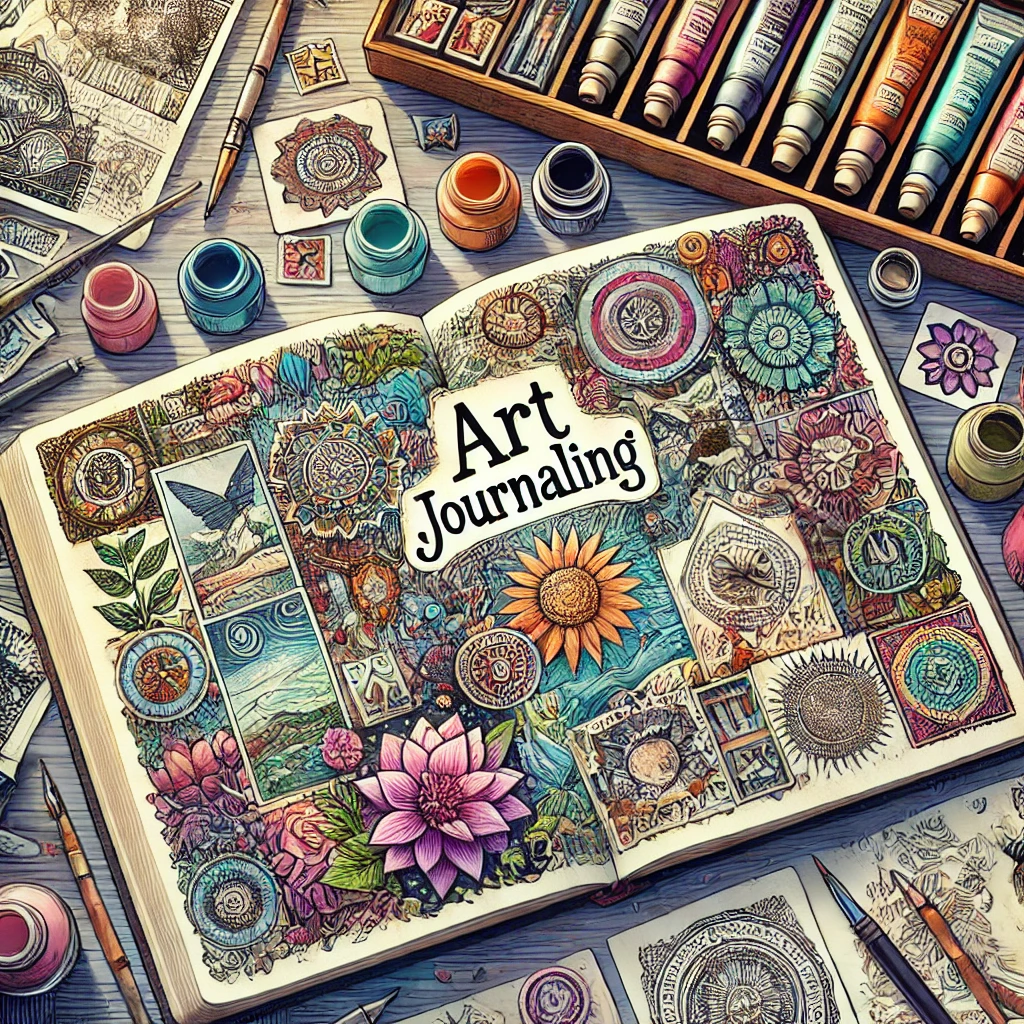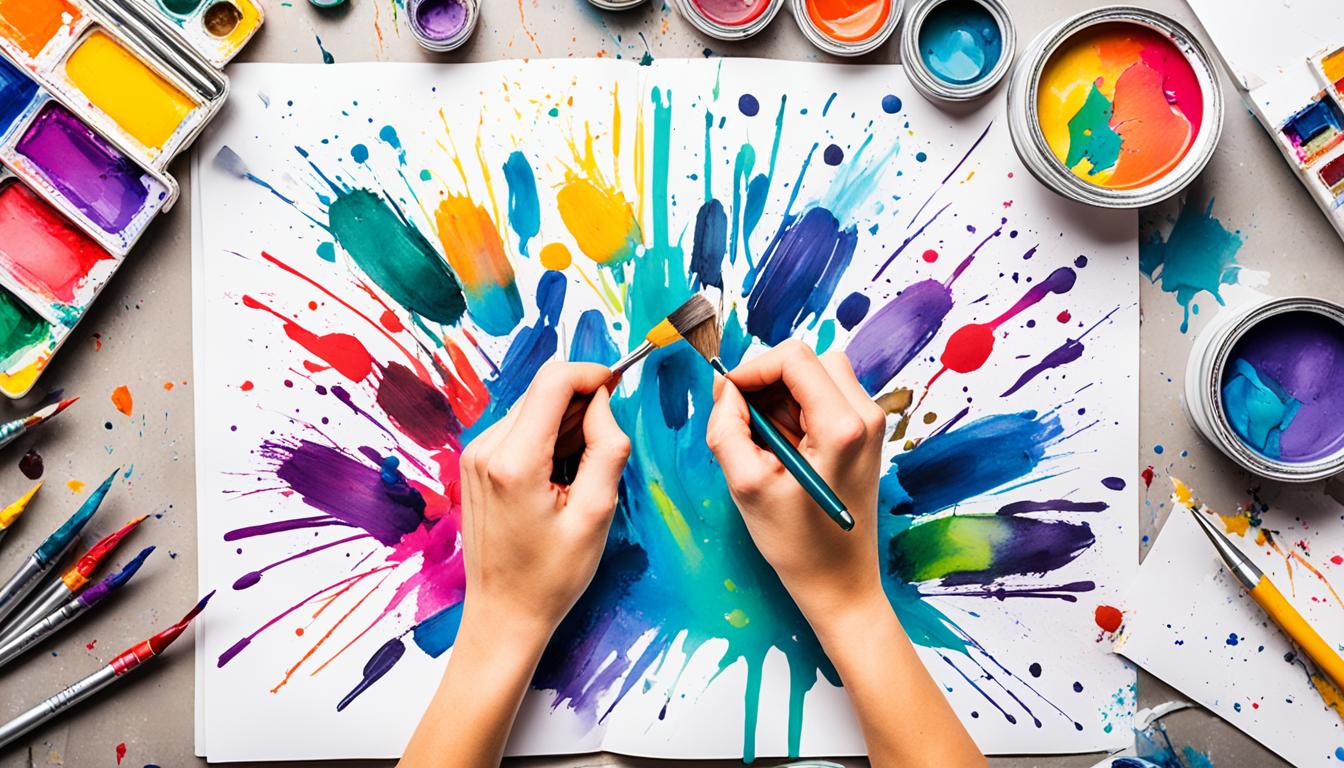Since 2007, monthly journaling has fascinated many. Whether through newsletters or Instagram, it helps us grow. We explore our creativity through various types of journals like artist’s books and bullet journals.

Creative journaling is free and easy. You can use any materials like pens or found papers. Adding personal items makes it unique and fun. This yearly project can be done every few months for busy folks.
Starting in 2007, journaling connects many people. It brings new art ideas regularly. Every page can be a work of art and memory.
What is Monthly Journaling?
Monthly journaling is a cool way to keep a creative diary. You pick different things to write about each month. This way, you end up with a fun, meaningful record of your life. It helps you think and dream, making you grow as a person.
Definition and Overview
Think of monthly journaling as an organized diary. You choose topics like dreams, friends, or goals for each month. This practice helps you to enjoy quiet thinking time. It’s a mix of sharing your thoughts and drawing or writing cool stuff.
Benefits of Monthly Journaling
There are many good things about writing in your journal every month. It helps you feel less stressed, sleep better, and understand your feelings. You also get to be very creative. This makes you feel happy and open to trying new things.
The best part is, you can change the topics to fit how you feel each month. So, it stays interesting. By looking back every few months, you can see how far you’ve come. This helps you plan what you want to work on next. Monthly journaling is a fun way to grow and enjoy life more.

Getting Started with Monthly Journaling
Starting a monthly journaling habit can really reward you. It’s not just helpful but also fun. If you’re starting or improving, the right tools and ways can help a lot. This guide will show you how to pick the best journal, get creative prompts, and choose the perfect supplies.
Choosing Your Journal
The first thing to do is pick your journal. You can choose from bound books, loose paper, or even digital apps. Many people like real notebooks for their hands-on feel. Brands like Moleskine, Leuchtturm1917, and Rhodia make great ones. If you’re new, know that any notebook works. You can always get a fancier one later.
Setting Up Monthly Prompts
Using prompts can help you focus your journaling every month. They can be about the season, how you’re feeling, or things you want to do. These prompts make it easier to put your thoughts on paper. For instance, you might write about a fresh start in spring or why you feel thankful in the autumn. Making your own prompts can make journaling more personal and fun.
Tools and Materials
The right supplies make monthly journaling even more fun. You need a good notebook and pen, like a Pilot G2 or a Tombow. For some flair, try brush pens, fine liners, and washi tape. If you love making your pages look cool and unique, use paper cutouts and glue.
Monthly Journaling Techniques
Journaling can improve how you express yourself and explore creativity. Art journaling, mixed media, and ephemera are three top techniques people love. They help capture your thoughts and stories in different, fun ways.
Art Journaling
Art journaling mixes art with writing to tell visual stories. You can draw, paint, or even stamp in your journal. Many find it a great way to de-stress and think about themselves. Whether you like messy art or neat designs, it’s all about what makes you feel best.

Mixed Media Techniques
Mixed media combines different art supplies in one space for an interesting look. You might use paint with letters or add photos to watercolors. This way, you can find your very own style to show who you are. It turns your journal into a place where everything you love can fit.
Incorporating Ephemera
Adding tickets or postcards to your journal creates a special story. These little things make your pages more personal. Your journal will become a reminder of all the cool things you’ve done. It’s like a treasure chest of memories, both big and small.
The Benefits of Monthly Journaling
Writing in a journal each month can really help your mental health. It makes you feel better emotionally and physically. Some studies found that writing about hard times for 15-20 minutes a day can lower your future stress. This can make you go to the doctor less and feel happier. It’s a great way to tell your own story and feel stronger.
Keeping a monthly journal can also help you sleep better and lower your stress. Being thankful in your journal is super good for you. A study showed that writing about five things you’re thankful for every day can make you more positive and peaceful. This is one of the best things you can do for your wellbeing.
Writing about your month can also help you make better choices. It makes you think carefully about what you do. This makes you remember things better and talk with others more clearly. It helps you get better as a person and have better friendships.

Having a journal is like having a special book of your life. It helps you learn from the past and choose better in the future. Starting to write might be hard, but it gets easier. A study showed that people felt less sad and mad after writing about tough times. So, it really helps to write things down.
In the end, making a journal each month is great for many reasons. It makes your mind and body feel better. It helps you grow as a person. And, it’s a nice way to keep track of how you’re changing over time.
Creating a Monthly Journaling Routine
Starting a monthly journaling routine is key for anyone who loves to write daily. It’s important to find the best times and places to write. This helps boost your commitment and success in journaling.
Finding the Right Time
For many, writing in their journal each morning fits perfectly into their day. Some, however, find doing a “worry dump” before bed helps them sleep better. It’s important to pick the time that works best for you. Early riser or night owl, choose a time that matches your own rhythm for the best results.

Making it a Habit
Being consistent is crucial when starting a journaling habit. Just a few minutes each day can help you better understand your feelings and actions. It’s good to have goals in your journal to help you stay focused. Also, looking back on what happened during your day can help you keep up the practice.
Add things like meditation to make your journaling even better. It can help you write with more confidence and clarity. Plus, it turns writing into something calming and healing. A monthly journaling routine will help you learn about yourself and grow personally.
Monthly Journaling Prompts
Monthly journaling prompts help us look at ourselves. They guide us to grow and be more creative. These prompts come from many places, like the changing seasons or special days. We can add colors, objects, and arts into our journal to make it exciting.

Inspiration for Each Month
Every month has a special theme based on feelings and the seasons. For example, January is great for writing and planning new goals. December is perfect for looking back and being thankful. These prompts make us think about our successes, challenges, and new things we’ve learned.
Examples and Ideas
Journals can be mostly about being thankful. About 40% of what we write should focus on what makes us happy. We can celebrate our wins another 20%. It’s good to remember our successes no matter how small they are. Dealing with tough times should be about 20% of our journal. This helps us grow. Finally, planning for the future should take up 20%. It’s important to think about what we want and make plans.
One idea is to list three goals for the month. Then, figure out what you need to do to reach them. Imagining your goals happening now can also be helpful. This way of writing makes us more focused. It helps us understand ourselves better. This is good for our mental well-being.
Deepening Your Monthly Journaling Practice
Improving your monthly journaling mixes deep thought and bright storytelling. This mix lets you grow a lot.
Reflective Writing
Writing about your thoughts is key for great journaling. It lets you dive into your feelings and life events, getting to know yourself more. By really noticing how you feel, you can see patterns and solve problems.
Try using ChatGPT for insightful reflection. It’s a helpful tool that’s private and open-minded, perfect for self-questioning. This can lead to a better mind and more personal growth.

Adding Lyrical Descriptions
Adding beautiful words to your journal makes it more like a story. This storytelling turns normal moments into lively memories. Including pretty language helps you remember and appreciate your past better.
Looking back on old entries and adding new thoughts can make you understand yourself even more. It’s a way to value your life journey. If you’re new to this, using AI for reflective journaling, as shown here, can help a lot.
By starting your day by calming your mind in your journal, you can live more in the moment. These habits help your mental well-being a lot.
Monthly Journaling for Personal Growth
Writing in a journal every month is a great way to grow personally. It helps you understand yourself better. You do this by looking at what you think, how you act, and how you’re changing.
Self-Reflection Techniques
Writing down your thoughts and asking yourself deep questions can really help you grow. You can also draw maps to see your dreams or write about how you feel about things. This will show you more about the way you think and feel.
Tracking Progress
Looking back at old journal pages can show you how you’ve changed. It might even help you see new things to work on. For example, you might notice that you now think more positively.
Journaling can really help you become more self-aware. Plus, it’s a method you can make work for you. It’s a way not just to write, but to change your life for the better.
Using Monthly Journaling for Creativity
Doing monthly journaling lets us try creative ways and art in our journals. You can mix different styles and add words with pictures. This makes your journal a place to show who you are.
Experimenting with Different Styles
Trying out various styles is great for creative journaling. You can get ideas from famous artists. They used their journals to test new things. You might try using different art or writing styles.
Combining sketches with stories, like Picasso did, can show new sides of you. Try using watercolors, doodles, or digital art in your journal. This makes your journaling more fun. Projects like The 100 Day Project can help you try new art styles.

Combining Words and Imagery
Mixing words and pictures can really boost your journal’s creativity. Mixing visuals and text tells a story in a special way. Artists like Andy Warhol showed us how to do this well.
Using a journal with great paper, like the Archer and Olive, helps your creations look better. It’s about more than just adding images to words. It’s sharing your story in a creative, visual way.
Inspirational Figures in Journaling
Many famous people have kept journals over the years. They used these diaries to write about their feelings and everyday life. People like Virginia Woolf, Susan Sontag, and Franz Kafka have shown how journaling can help in writing.

Virginia Woolf
Virginia Woolf was a key figure in modern literature. She wrote in a diary all her life. Her journals, which came out after she died, show how she thought deeply about herself. By writing without holding back, her books, such as “Mrs. Dalloway,” became better. Anyone looking to discover the power of journaling can look at her work.
Susan Sontag
Susan Sontag saw journals as pivotal for her growth, both personally and intellectually. Her journals mix everyday notes with deep thoughts on books and ideas. They show her honest self-awareness. Readers can learn from her detailed notes to become better at understanding emotions and creative thinking.
Franz Kafka
Kafka, known for “The Metamorphosis” and “The Trial,” used his journals to work through deep thoughts. His writing shows how his struggles influenced his work. By reflecting daily, Kafka better understood himself and managed his worries. His method teaches today’s writers how to grow personally through journaling.
Monthly Journaling Tips and Tricks
Starting monthly journaling is both fun and tricky. Knowing some tips can make it easier. Here’s advice to guide you over the common hurdles.
Overcoming Creative Blocks
Sometimes, we hit a wall with our writing. To get over it, look for ideas in your everyday life. Think back on your ‘one line a day’ journal from three years ago. Or, list happy moments from the last ten years.
Use prompts to break through creative barriers. Try 57 art journaling prompts or explore ten different journal themes. Writing whatever comes to mind for three pages in your morning pages can be freeing. It encourages you to write without worrying about making it perfect.
Maintaining Consistency
Sticking to a journal can be hard. A lot of people start but then find it tough to keep going. They might only fill 5-10 pages each time. Developing a consistent journaling routine is key.
Set goals you can actually reach. Plan ahead with tools like bullet journaling. BuJo creators always start with an Index. You can track your water intake or list your favorite things each month. Your journal should meet your needs, keeping you interested and committed.
Try journaling every day, even if it’s just a little bit. Using small books or sets can make this easier. Challenge yourself to keep it up for two months. Seeing a long chain of days written down can motivate you to continue.
Conclusion
Journaling can make a big difference in personal growth, creativity, and mindfulness. With methods like art journaling, mixed media, and writing reflections, people start a journey of self-expression and goal achievement. This structured routine with various prompts can change how we live each day. It gives us a way to know ourselves better through writing.
92% of people say journaling helps with reflection, and 67% feel it aids in setting new goals. These high numbers show how useful monthly journaling is. It helps not only with being creative but also with finding and breaking personal limits. By making checklists and setting up monthly reviews, 73% find this method useful and 60% stick to it. Using this organized method, you can make journaling a key tool for getting better over time.
We recommend you try these tips in your journaling adventure, no matter your writing level. There are lots of good things that come from journaling, ready for you to enjoy. Take this chance to find out more about yourself through writing. Make the most out of recording your experiences, seeing your growth, and trying new creative things. Enjoy your journaling time!
FAQ
What is Monthly Journaling?
Monthly Journaling is a creative challenge for a year. It uses monthly themes and prompts to keep you inspired. You can mix art with writing freely in your journal.
What are the benefits of Monthly Journaling?
It boosts your creativity and helps you understand yourself better. You’ll be more mindful and remember things clearer. It’s a great way to grow personally by reflecting on your life.
How do I get started with Monthly Journaling?
First, pick your journal style, like a Moleskine or digital platform. Then, set up monthly topics based on your own interests. Don’t forget your art supplies like paints and pens.
How do I choose the right journal for my needs?
Think about how you like to journal. Moleskine is a good all-around choice. But, any type that fits your creative and writing style will do.
What are some examples of Monthly Journaling techniques?
You can try art journaling or include different materials like ticket stubs. Use paints, collages, or stamps for unique pages. This makes your journal visually interesting and fun.
How does Monthly Journaling benefit mental health?
It is good for your mind because it makes you more aware and helps you express yourself. Writing and creating can help you sleep better and feel more confident. It’s a positive way to spend your time.
How do I establish a consistent Monthly Journaling routine?
Choose a regular time to journal, like in the morning or before bed. Writing every day, even just a little bit, is key. Make small goals and plan your topics to stay on track.
Can you provide some inspiration for monthly journaling prompts?
Your ideas can come from the seasons, holidays, or your own life. Try using different colors, found objects, or new painting techniques. Past prompts can also give you good ideas.
What are some self-reflection techniques for deeper journaling?
To reflect, ask yourself deep questions or map out your goals. Write about how you feel in response to events. Looking back on what you write can show you how you’ve grown.
How can journaling enhance creativity?
By mixing art and stories, your journal becomes more creative. Try new art styles, writing voices, and formats. This keeps your ideas flowing.
Which notable figures have used journaling for creativity and personal growth?
Virginia Woolf, Susan Sontag, and Franz Kafka used journals creatively. Their journals help us understand their art and can inspire us too.
How can I overcome creative blocks in journaling?
Look around for inspiration and don’t be afraid to be imperfect. Write regularly to keep your creativity flowing. Setting goals will also help keep you moving forward.
What are some tips for maintaining consistency in journaling?
Journal every day as part of your routine. Set small goals and decide on your topics ahead of time. Creating a cozy place to journal can make it a favorite part of your day.

More Posts
Best Personal Development Books You Should Read
Many of Us are always seeking knowledge and eager to learn more. There are many mediums to explore, books are one of them. There is a range of personal development books available that...
Time Tracking Benefits for Freelancers & Small Business Owners
Time is a valuable resource, and tracking it efficiently is crucial to the success of freelancers and small business owners. One powerful tool that can help optimize time management is time tracking. By...
10 Tips to Optimize Your Monthly Reset Routine in 2024
Efficiently closing out each month with a structured monthly refresh can significantly enhance your overall productivity boost and well-being. As we step into 2024, establishing a well-thought-out reset routine becomes indispensable for ongoing life optimization. Reflecting...
Fixed Schedule Pros and Cons: A Comprehensive Overview
A fixed schedule means workers follow the same timetable every day. This helps with being on time and keeps things running smoothly. It starts with planning out the work hours and days for...